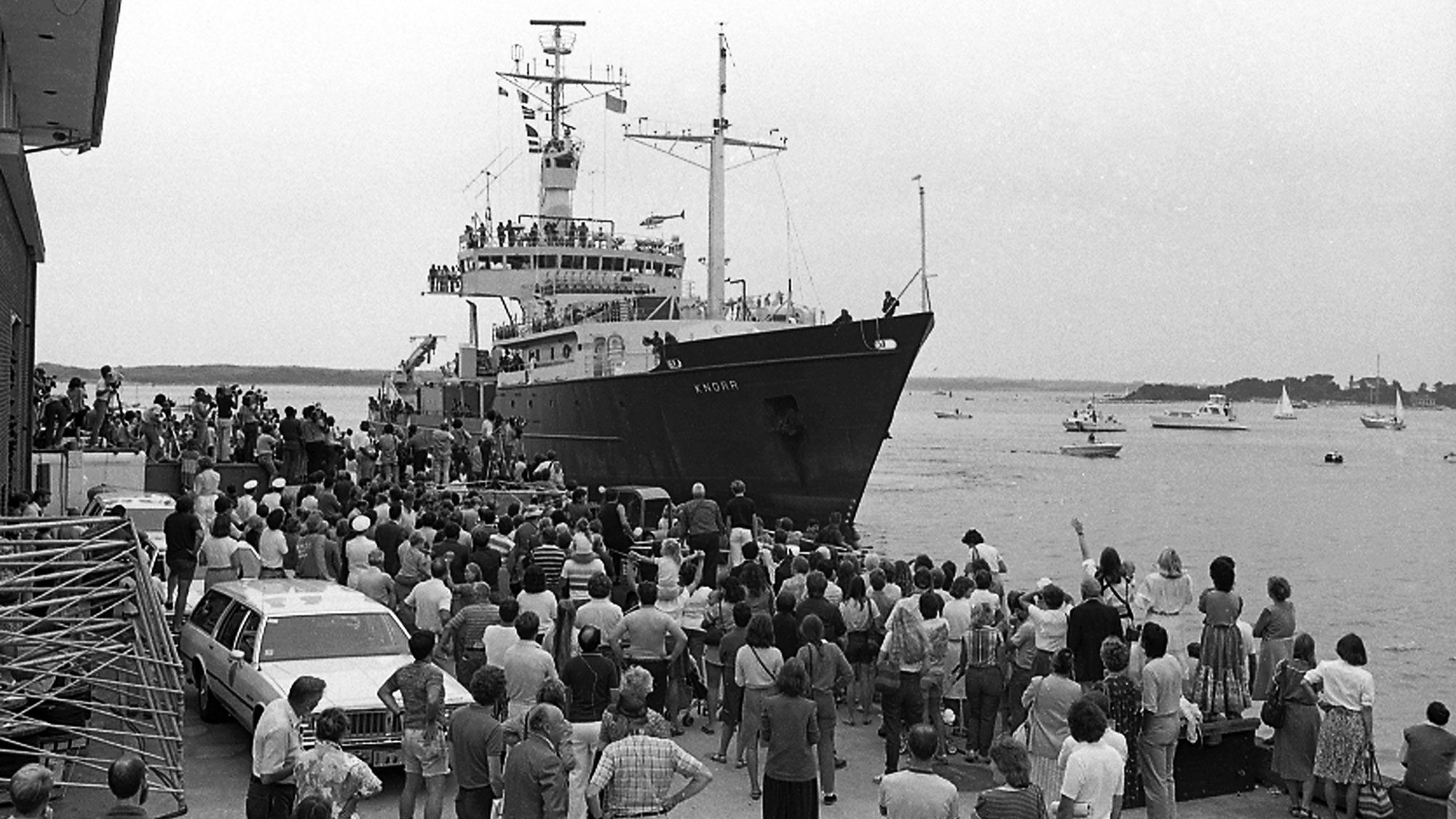Forty years ago, we helped find the Titanic. This is what it means to us today.
Published: September 9, 2025

by Stewart Harris and Dana Yoerger
Forty years ago, on September 9, 1985, we returned to port in Woods Hole, Massachusetts, after a research expedition in the North Atlantic, to a media frenzy few seagoing scientists have ever experienced.
We had spent the past month aboard the research vessel Knorr as part of a joint U.S.-French expedition surveying the seafloor nearly two miles beneath the surface. Everyone was exhausted by many days of seeing nothing but featureless expanses on the video screen when, on September 1, the unmistakable outline of something made by human hands came into view—a boiler. We had found the wreck of RMS Titanic and the final resting place of more than 1,500 souls.
When the news broke a few days later, the media erupted in a hunger for all things related to the great ship that resulted in our tumultuous homecoming and that continues today.
Although the technology that helped us make that discovery was simple by today’s standards—essentially a video camera and lights inside a metal sled towed behind the ship—it similarly marked a turning point in the way people viewed the distant, nearly invisible parts of our planet.
In the decades since, we’ve followed different paths. One of us continued exploring the deep ocean, the other, deep space. And yet, the work we do is driven by the same impulse: to create new technologies that enable us to venture into the unknown, to push the limits of what we can perceive, and to reveal places and phenomena no human has seen before.
These pursuits aren’t escapism. They’re about understanding our planet, our universe, and ultimately ourselves. Discovery—whether on the ocean floor or in outer space—is rarely marked by a dramatic eureka moment. More often, it’s the culmination of years, sometimes decades, of incremental advances, and quiet persistence. But when a breakthrough does come, its reverberations can be felt far beyond the lab or our shipboard control room.
We know there are many pressing issues that demand urgent attention—poverty, inequality, conflict. And, yes, public resources are finite. But framing exploration as a distraction or indulgence misses the point. It’s precisely during uncertain times that we most need sources of inspiration to tackle big problems. When we invest in exploration, we are also investing in education, innovation, and the future. Moreover, our innovations inevitably produce benefits we could not have anticipated, helping us understand how our planet works, to protect the environment, and to defend our country.
The day we found Titanic was, for many people, the first time they gave serious thought to the vast, dark ocean depths. Those images sparked imaginations around the world, planting seeds in the minds of students, artists, teachers, and scientists—some of whom have gone on to become the next generation of explorers in their field.
Technology developed for ocean and space exploration has advanced considerably since the days of the Titanic discovery. Robots like those used to search for shipwrecks have a myriad of applications, such as understanding the fundamental geological processes that shape our planet, exploring the vast and complex webs of ocean life, and enabling us to respond to natural and human-made disasters. The cameras aimed at distant parts of our galaxy and the universe have helped improve the cameras in our pockets, in our hospitals, and that look down on us to monitor the health of our planet.
But beyond practical benefits, exploration touches something deeply human. The drive to discover is embedded in our DNA. It fuels creativity, collaboration, and a shared sense of purpose that transcends borders. We need that sense of connection to ourselves and our planet now more than ever.
Exploration is not about conquest, but about humility. Looking at a lush hydrothermal vent ecosystem or probing the pulsating corona of the Sun reminds us how precious this tiny, improbable pale blue dot truly is.
As we mark four decades since that momentous discovery aboard Knorr, we are reminded that exploration—tiring, painstaking, and often unglamorous—is a long arc. The stories that capture the world’s attention are just the tip of that arc. They point back to legions of engineers, pilots, cooks, interns, scientists, ship crews, programmers, and supportive families back home—all part of a chain of effort and belief.
In the end, what we seek isn’t just knowledge. It’s wonder–the same wonder that transfixed the world in 1985 as the ghostly form of Titanic emerged from the darkness. The same wonder that can stir a child to ask, “What else is out there?” We owe it to future generations to keep looking.
Stewart Harris is an Aerospace Engineer (ret) at the Space Sciences Laboratory, University of California Berkeley. Dana Yoerger is a Senior Scientist at the Woods Hole Oceanographic Institution. Both were on the 1985 expedition that discovered RMS Titanic.
